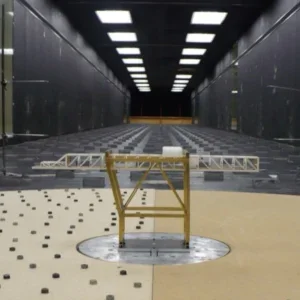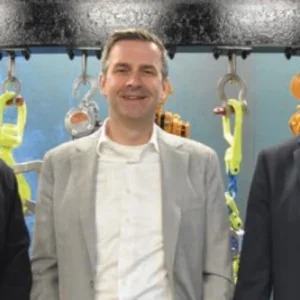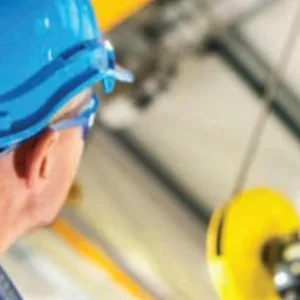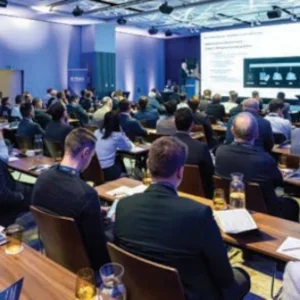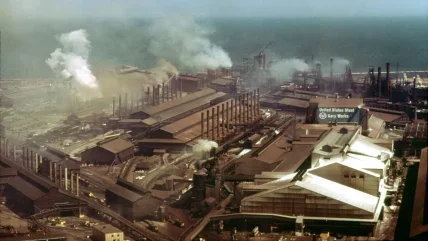
"When a major US steel mill in Arkansas required a new approach to coil handling for its rolled-to-order production strategy, its engineering and materials handling equipment partner, Morgan Automation, devised and implemented a fully automated, non-manned series of three cranes to work with two coil transfer cars accepting hot coils off the walking beam from the hot mill" In manufacturing this system solution, Morgan turned to its long-time drives and motion control partner, Siemens, which provided a full complement of drive, programmable logic controller (PLC), safety input/output (I/O), power quality meters, PCs, wireless hardware plus communication software and its Totally Integrated Automation (TIA) Portal for commissioning and monitoring on the project.
“The excellent reliability and performance of the Siemens solution on this project was invaluable in helping us achieve complete operational efficiency and zero downtime during the first six months of operation,” says the president of Morgan Automation, Mark Sharamitaro.
This project involves the handling of approximately 1,000 coils or 30,000 tons of steel a day at the mill. A typical coil in this yard measures approximately 83in (outside diameter) by 82in (width) and weighs 28 tons on average. As the mill operates on a ‘made to order’ mindset, there is a dual challenge of handling hot coils from the mill and organising their staging for shipment by truck, rail or barge, with an area (a quadrant) for coils heading via the coil transfer cars provided by Morgan to the pickling line tandem cold mill (the PLTCM is a production line that chemically cleans and flattens steel coils, utilising pickling and tandem cold rolling techniques) on the premises.
In the yard, the walking beam delivers the coils from the hot mill, then the crane grab secures the individual coils and places them in the coil transfer car or on a saddle in the appropriate quadrant on the floor. During low production times, the system reorganises the coil assortment into the proper positions to conserve storage space – filling empty storage spaces and grouping common destination coils together – with full tracking in real time. Each crane has a thermal imaging camera for temperature sensing plus a laser positioning system that reports its exact location on the yard. The thermal imaging cameras ensure coils are not moved until they cool, and the order in which coils are moved is prioritised based on the facility’s workflow. The comprehensive data tracking is displayed in the mill control room with real-time key performance indicator (KPI) calculations.
The goals for the autonomous yard included reduced rust and corrosion by eliminating the need for outdoor coil storage, improved coil handling to meet the shipping protocols, reduced energy costs by eliminating lift truck handling, and reduced physical distancing of coils through dense coil storage indoors, plus faster location of the coils on their saddles for crane handling into shipment staging areas.
Integration of the entire operation is handled by the proprietary Morgan Cephas logistic management system, which performs inventory tracking and routes every coil from the mill to the shipping stage in a time-sensitive and deterministic order of motion, with a rules-based engine for algorithmic decision-making. Cephas uses a custom yard map to optimise the placement of every coil, logging its position for precise inventory tracking. To optimise the efficiency of coil storage, the team at Morgan programmed Cephas to divide the yard into four quadrants, where coils are stored according to their final destination. Before receiving a coil, Cephas gathers and records all primary data associated with the coil. This includes its production specifications, as well as final shipping details.
When it’s time for a coil to leave the yard, Cephas knows exactly where to find it and will retrieve it automatically. The system is tightly integrated with the mill’s production and shipping schedule so that coils destined to leave the facility are automatically placed on a saddle where they can be handled by a forklift or placed on the transfer car and automatically moved to the PLTCM.
All the information management is transmitted and handled by mill personnel, using the in-house platform and virtual private network (VPN).
Morgan worked with the Siemens team to utilise the full range of product and software options for construction of the optimum materials handling, motion control and data management system for the yard.
“When we automate operations, our team always starts with a thorough analysis of a company’s existing processes,” says Sharamitaro. “Then, we apply our decades of engineering experience to design a custom automation system that addresses the challenges of that unique application.
“We were bringing our established Cephas warehouse management system to this challenge and seeking to marry it to a single user interface, driven by the rules established by our customer, so there’s essentially a single bucket of data on each coil,” says Sharamitaro.
In that ‘bucket’ are all the physical characteristics and temperature of the coil plus the determined location for placement. The data is transmitted through a series of Siemens Sinamics drive modules, Simatic PLCs and the Sinema network monitoring server, complemented by Simatic WinCC V16 supervisory control for monitoring over long distances. In addition, Siemens offered its Scalance wireless suite of ethernet switches and access points to communicate the ring topology and virtual local area network (VLAN) data to the mill control room personnel.
Siemens Siplus controller components were used outside of the e-house (a prefabricated space that houses electrical equipment and systems) because of the higher ambient temperatures, as these devices are built for more hostile environments. Sharamitaro reports that the Morgan team tested these components beyond their published ratings, so his team knew the components would perform in this application, especially at the moment when the crane would pick up a hot coil and hoist it up near the trolley with the controls onboard.
Sharamitaro also notes the need for an embedded quality system to identify secondary coils on the floor and determine their transfer path. As each coil is grabbed, a full battery of sensors, switches, I/O power supply, drives, PLCs and wireless communication sends information from the crane trolley directly to the control house. The three 190-ton cranes are thus fully synchronised for handling the incoming coils from the hot mill plus the placement of the coils in the transfer cars and staging lines. The information feeds the Cephas system, which makes the algorithmic determinations for each coil, based on predetermined parameters set by the mill.
“When the system is in operation, every movement is carefully orchestrated, and every sensor is continuously monitored and logged with its time stamp,” says Sharamitaro. “This real-time data collection and evaluation allows the team at [the steel company] to continually identify and improve operational performance.”
SAFETY
Morgan Automation integrated a number of safety-related features into the project, including a ground-based safety system that help protect workers from passing cranes. Mill personnel cannot access any of the four quadrants in the yard if the lockout devices are engaged. The system ‘asks’ the crane for permission before allowing personnel to access the area. Nine remote I/O cabinets and 21 safety gates were implemented.
Sidewall sensors prevent the crane from damaging coils, while a selfcentring device ensures they are always positioned perfectly.
One of the individuals leading the project for Siemens was Roland Najbar, business development manager.
“Once we had the full requirements from Morgan, we went to work assembling our motion control and material handling product and software suites to accommodate them,” says Najbar. “The need for fully unattended operation and wireless communication in the mill presented some challenges, but our team responded with a combination of timetested drive, wireless and PLC products as well as some newer offerings such as the Sinema network monitoring system.”
He further notes that Morgan took the Siemens offerings to new heights of performance, through the integration with Cephas.
Najbar also cites the intentional redundancy in the drive safety and production isolation that allowed the cranes to keep working independently but in a highly integrated manner to achieve a non-stop production environment at the mill. The open communication protocol on the Siemens Simatic S7-1500TF PLC allows for C++ high-level language applications, such as protocol converters, database connectivity, and complex algorithms such as those on the Morgan Cephas system, plus integration of crane vision systems and laser trackers.
To evidence the energy savings, Siemens also provided its PAC3200 power meters that track and record power consumption and communicate data over a network protocol. Another key component in the Siemens solution here was the Sinamics S120 Smart Line Module for crane applications, which features onboard regenerative drive. This feature takes the excess motor power from a crane hoist, for example, during descent and feeds it to another component in the system or back to the grid for trackable energy savings to the customer.
Since commissioning the Morgan system, the facility is said to have improved operational efficiency, increased machine availability and reliability, reduced fuel costs, more efficiently utilised personnel labour, and reduced cycle times.
“We’re a technology company that just happens to make steel,” says the CEO of the steel company. “We embrace automation, big data mining, accurate measurements – whether it be weights, consumption, what have you – in everything that we do.
“Morgan understands where the future of industrial America and industrial operations through the world need to get to to maintain top-level performance.”
Morgan Automation is sister company to Morgan Engineering and part of the Morgan Industries group of companies, which has served the steel industry for over 150 years. Morgan Engineering is a designer of overhead electric travelling cranes, and manufacturer of more than 30,000 cranes.


